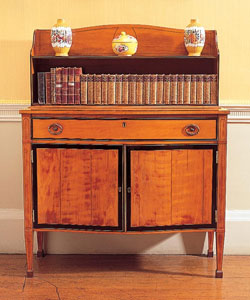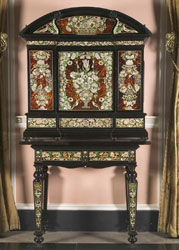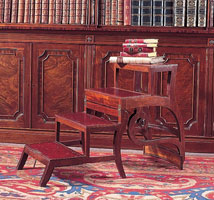The Furniture
 The Mansion at Tatton Park is perhaps best known for its outstanding collection of furniture by the maker, Gillows of Lancaster. Over 200 pieces were commissioned by the family for the Mansion and many of these can still be seen in their original setting in the house.
The Mansion at Tatton Park is perhaps best known for its outstanding collection of furniture by the maker, Gillows of Lancaster. Over 200 pieces were commissioned by the family for the Mansion and many of these can still be seen in their original setting in the house.
Robert Gillow established his firm in 1728 in Lancaster and subsequently opened a branch in London. At this time, furniture was also being traded to the West Indies from whence Gillows obtained the exotic hardwoods used in the production of some of their furniture designs.
Gillows kept meticulous records, including a series of Estimate Books from 1784 to 1905, and from these it is often possible to identify the maker and original cost of the pieces.
Gillows received the patronage of both William Egerton in the late 18th and Wilbraham Egerton in the early 19th centuries. Wilbraham and his wife Elizabeth furnished the Mansion almost entirely with especially commissioned Gillows pieces. French, English and Italian pieces collected
by the family complement the renowned Gillows collection and are displayed
throughout the Mansion.
We are delighted to announce that our Gillows Architect's Desk has been selected as a piece within a web-based project called A History of the North in 100 Objects, a project intended to showcase the pioneering spirit and impact of the North of England’s inventors, artists, scientists and designers. Funded by the National Lottery and developed by Tyne & Wear Archives & Museums (TWAM) the online exhibition runs from 22 June – 9 September 2018. Alternatively come and see the Architects' Desk within our Mansion; it's currently situated in the Egerton Exhibition Room.
Gillows “Cheverets”
The photograph above shows one of a pair of satinwood cabinets with black inlays supplied by Gillows to the Egerton family. A Gillows estimate dated 31st July 1790 shows that they cost £5 10s. 10 1/2d each to make and the maker was James Burton. These can be seen in the Yellow Drawing Room
Northern Italian Jewel Cabinet
Circa mid 19th century, the ebonised wood of this exquisite cabinet (see right) is inlaid in ivory and mother of pearl. Intricate patterns of flora and fauna decorate each surface and the ivory is stained a green colour to contrast with the other materials. The fall flap opening encloses 11 drawers.
The quality of the craftsmanship is outstanding. The cabinet can be seen in the Entrance Hall.
Metamorphic Library Chair*
Metamorphic furniture is designed to have a dual or multiple-purpose. Modern examples include the sofa-bed.
During the middle of the 18th century there was a fascination for mechanical
furniture and between 1770 and 1820 a wide variety of metamorphic designs
emerged.
This chair was probably made by Morgan and Sanders in London around 1811. By releasing a small catch on the rear split stretcher of the chair, the back and seat hinge forward to reveal a set of four steps.
Since the chair has no castors and there is little evidence of wear on the leather-covered steps, it is likely that it was purchased as a conversation piece rather than as a practical object.
Books from the higher shelves of the bookcases would probably have been reached using the library ladder.
*With thanks to Clive Taylor for the information on this piece of furniture